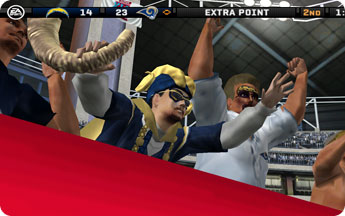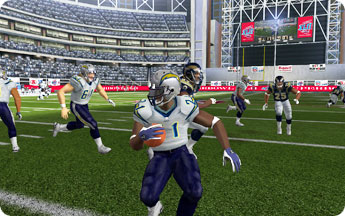Tips and Tricks

- When calling a formation on defense, pay attention to the box that tells you how many wide receivers, tight ends, and running backs your opponent is sending on the field. More wide receivers means they’ll likely pass, and more running backs and tight ends means they’ll likely run. That information is also useful if you’re not sure whether they will likely run a play on fourth down, rather than punt or attempt a field goal.
- If you expect your opponent to go into a no-huddle offense, which means they’re going to line up and snap the ball as soon as a play ends, call a defense that you’re comfortable leaving on the field in such a situation. A no-huddle offense means they’re going to throw the ball a lot, so a nickel or dime package is your best choice. Yes, you can call defensive audibles at the line of scrimmage, but you won’t be able to get substitutions on the field.
- The same holds true of the no-huddle on offense: pick a pass play you’re happy with, because you will run it over and over again, unless you call an audible — even then, you’ll be stuck with the personnel on the field.
- When punting near mid-field, angle the kicking arrow up a bit before hiking the ball. Your punt will stay in the air longer, potentially forcing the receiver to call for a fair catch deep in his end of the field. In addition, if the receiver declines to catch the kick, the ball has a better chance of bouncing away from the end zone when it lands, giving your players an opportunity to down it and pin the other team inside the 20-yard line.
- You can’t challenge the results of a play after you’ve watched a replay of it, so you’ll have to decide whether or not to throw the red flag based on what you saw during the action, just like a real coach. And don’t forget that you have to challenge a call before the next snap, or you lose the opportunity.
- If you’re not sure which play to call or which defense to send out, don’t be shy about selecting the Ask Madden option to see what our esteemed color commentator thinks you should do.
- Conserve a few precious seconds after calling your play by sprinting to the line of scrimmage (button 2 on your gamepad; D if you’re using just your keyboard; and the spacebar if you’re using your keyboard and mouse).
- Mix up your playcalling. Players you challenge online will eat you alive if you don’t, but the computer will learn your tendencies too, if you become too predictable. For example, establish a solid running game and then call some play-action passes, which fake the other team into thinking that you’re going to run. Or call a pass in a short-yardage situation that would typically dictate a run, but make sure you do so out of a formation that doesn’t scream “They’re going to pass!” (A shotgun formation almost always means a pass, but an I formation often looks like a run, for example.)
- Watch the clock. Don’t squander precious seconds at any time, even during the first quarter. With each play typically taking five to ten seconds to execute, you want to cram in as many plays as you can, especially late in the second and fourth quarters. Don’t be the kind of coach who calls timeouts at inopportune moments.
- If you want to play with a gamepad, make sure you have one with a pair of analog sticks, such as the Mad Catz GamePad Pro Series 400. The second stick is required to kick-off and attempt field goals, as well as for using the Hit Stick 2.0 feature.
- A gamepad also allows you to dictate the strength of your passes: press the button hard to rifle the ball to the receiver, or touch it softly to lob it over the defender’s head.
The John Madden-Apple connection stretches back to 1986, when the former college football player and Oakland Raiders head coach met with Trip Hawkins, who in 1982 had left his job as an Apple Computer executive to found Electronic Arts. The early days of computer football games were typically crude efforts that didn’t adhere to NFL rules, and Madden would have none of that if he became involved with the new game Hawkins was pitching to him.
Luckily, Hawkins was a lifelong sports fan who used to play the dice-and-paper-based Strat-O-Matic baseball and football games, so he was prepared to promise Madden an experience that would be as true to reality as the technology of the era would allow. Three years later, the inaugural edition of John Madden Football launched for MS-DOS and the Apple II, immediately differentiating itself from the competition with its use of real NFL teams. (The absence of licenses from the NFL and the NFL Players Association meant that actual team and player names weren’t used, but the digital versions were based on their real-life counterparts.)
As the series progressed into the 1990s, it expanded onto other computer operating systems and videogame consoles, improving in visual quality with each annual version and eventually gaining those coveted official NFL and Players and Coaches Association licenses. Madden had begun his broadcasting career when Hawkins met him, so as soon as the technology allowed it, his lively commentary became part of the game, along with Pat Summerall’s smooth play-by-play. Later, Al Michaels took Summerall’s place, ensuring an even-keeled counterpart to Madden’s “Boom! That hit knocked him out of his shoes!” and other colorful observations.
Smith notes that Madden’s involvement continues to this day. “We send him the version of the game before we are finished and make sure we have the Madden stamp of approval,” he says.
Competitive Iterations
In addition to graphical and audio improvements, the Madden series’ basic gameplay evolved, with continual refinements to the controls. Each new version also reflects changes to NFL rules, which have included the adoption of the two-point conversion, the ability to challenge referees’ calls, and other additions over the past 18 years. In addition, the game has incorporated more and more team management functions, allowing players to control all franchise decisions, from draft picks to player salaries, if they want.
Another change to the series arrived in 1998, when EA began including the photo of a prominent player on the cover of the game, rather than the image of Madden that was previously used. The first one went to Garrison Hearst, a prominent San Francisco 49ers running back who broke his ankle in a playoff game that season. Thus began talk of a “Madden cover curse,” thanks to the fact that many of the players who have appeared on the cover suffered injuries or played poorly afterward.
“The individuals who we select for the cover are marquee players who have the ball in their hands a lot, and therefore experience a lot of contact,” Smith points out. “Other NFL teams also game plan to stop marquee players, so we don’t give a lot of credence to the ‘cover curse.’”
In the meantime, “it’s in the game,” as EA Sports likes to say, and the Madden series will continue to live up to that concept for a long time to come.

And the Crowd Goes Wild. Fans cheer after their team scores an exciting touchdown.

Fake-Out. Quick cuts to the left or right help you avoid tacklers.
- Mac OS X version 10.4.9
- 1.83GHz Intel Core Duo processor or higher
- 1GB of RAM
- ATI X1600, NVIDIA GeForce 7300 GT, or higher video card (Intel GMA950 chipset not supported)
- 2.2GB hard disk space
- 8X DVD-ROM drive
